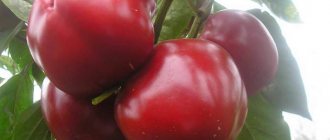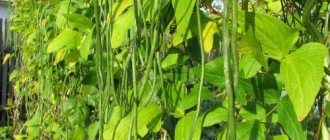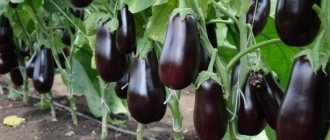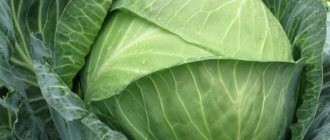Characteristics of cabbage
The vegetable acquired its harsh name due to its unique characteristics. The F1 Aggressor is primarily noted for its strong and rapid growth. Also, the variety is not afraid of weeds and has fairly good immunity, which allows it to resist diseases and is rarely infested by insects.
The rosette of the crop is of a raised type. The leaves are round, concave or slightly bubbly, and medium in size. Color – gray-green.
A waxy coating may occur on the surface of cabbage leaves. Depending on the growing conditions, it can be of medium or strong intensity. The edge of the leaf has a characteristic slight waviness.
The head of cabbage is flat-round in shape. If we compare the head of Aggressor with other varieties, it is relatively small: from 2 to 5 kg.
When cut, the vegetable is yellow-white in color.
The variety's planting density on average fluctuates around 35,000 pieces per 1 hectare of planting. Of the harvested crop, about 93-96% can be used for sale. On average, 43-56 tons can be collected from 1 hectare.
The ripening period for Aggressor F1 is 130-150 days.
Origin and distribution
Cabbage "Aggressor" is a hybrid of the first generation (F1), which was created by specialists from the famous. The originator does not disclose information about the varieties that served as parent forms during breeding.
In the photo - planting material in packages of various domestic agricultural companies (AliExpress offers seeds from the Timiryazevsky nursery and the Dutch company Syngenta)
Syngenta is a large international company operating in the field of agribusiness, one of the leaders in the production and supply of seeds of vegetable, grain and ornamental crops, as well as plant protection products. The headquarters is located in Switzerland, and is currently owned by the Chinese corporation ChemChina.
In 2001, an application was submitted to the State Variety Commission to include the Aggressor F1 hybrid in the register of selection achievements. In the course of standard field tests, by 2003, a new variety of crop was zoned in the Central region. Currently, this cabbage is recommended for cultivation throughout almost the entire territory of Russia.
Cabbage from the category of modern hybrids is successfully grown by both large vegetable producers and amateur gardeners
F1 hybrids are highly valued in the world. Compared to conventional varieties, they have improved yields, marketability, transportability, resistance to diseases and adverse factors. Hybrid forms are obtained by crossing varieties with different valuable traits. As a result, the phenomenon of heterosis is observed, that is, the descendants of the first generation (F1) are superior to the parent plants in certain or several characteristics. They do not inherit a stable combination of genes - in the second and subsequent generations, heterosis decreases sharply. Therefore, it makes no sense to collect “your” seeds from F1 hybrids for further cultivation .
Advantages and disadvantages of the variety
Despite the fact that this is a relatively young variety, it has become one of the most cultivated today. The Aggressor managed to achieve this position due to a large number of advantages. In particular, the advantages of Aggressor F1 include:
- Excellent taste.
- Heads of cabbage are not prone to cracking during cabbage storage.
- The leaves are very juicy and crunchy well.
- Aggressor F1 contains a large amount of vitamin C, which makes it possible to include it in the diet of young children or use cabbage as a dietary product.
- High commodity value.
- The aggressor has a powerful root system.
- It can easily be transported over long distances, which makes cabbage attractive for commercial use.
- Aggressor F1 is characterized by uniform harvest ripening.
- The germination rate of seeds of this variety reaches 100%.
- Unlike many other cabbage varieties, Aggressor tolerates short periods of water shortage well.
- Normally tolerates elevated temperatures that occur when cultivating crops in the southern regions.
- It is also not afraid of low temperatures.
- Aggressor F1 is one of the most highly productive cabbage varieties.
In addition, it is worth noting a number of other advantages. Aggressor is a universal variety. Cabbage is suitable for consumption raw; it can be used to prepare salads, stews, etc. In addition, the vegetable can be fermented for the winter.
Typically, heads of cabbage are stored for up to 5 months. Under ideal conditions, the shelf life can be increased to 6-6.5 months.
At the same time, one should not turn a blind eye to the Aggressor’s shortcomings. The disadvantages of this variety include:
- Sometimes heads of cabbage grow with rather hard leaves. These are isolated cases, but alas, they do occur.
- During pickling, an unpleasant bitterness may appear.
- The crop is not protected from aphids and whiteflies.
Description of cabbage hybrid Aggressor F1
The new high-yielding hybrid of white cabbage deserves one of the honorable places among Russian varieties. With simple care, despite the average size of the heads of cabbage, the Aggressor demonstrates high yields - more than sufficient for cultivation for personal purposes and for sale.
Origin and development
Cabbage, originally from Holland, is rapidly gaining popularity in the Russian Federation and the CIS countries. Intended for cultivation in all zones of the country, except northern latitudes.
The hybrid was created by Dutch seed breeders (Syngenta Seeds BV). In 2003 it was included in the State Register of Russia. The name was given to the hybrid for its fast, powerful growth, resistance to pests, diseases and weeds.
Chemical composition and beneficial properties
The calorie content of Aggressor cabbage is 27 kcal per 100 g.
Contains a whole complex of nutrients and vitamins:
- Proteins, fats, carbohydrates, dietary fiber.
- 16 free amino acids (including tryptophan, lysine, methionine, tyrosine, histamine, etc.).
- Vitamins B, A, C, E, K, PP, as well as U, which has an antiulcer effect.
- The mineral composition is varied, including potassium, sulfur, calcium, phosphorus, magnesium, iron, cobalt, iodine, copper, zinc, manganese, etc.
Thanks to such a rich complex of chemicals, cabbage has many beneficial properties:
- Strengthens the immune system.
- Cleanses the body of toxins, cholesterol and other harmful substances.
- Prevents the development of atherosclerosis.
- Stabilizes blood sugar levels.
- Reduces the risk of developing pathologies of the heart and blood vessels.
- Improves liver and gall bladder functions.
- Reduces the risk of developing gout.
- Relieves joint pain.
- Prevents the development of benign and malignant neoplasms.
Features of application
The leaf pulp of the hybrid is juicy, crispy and very healthy, so it is often used to prepare fresh salads. It is added to first courses, stewed, fried, fermented, pickled. Aggressor cabbage is suitable for pickling and preparing other winter preparations, as it tolerates heat treatment well.
Ripening period
The ripening period for cabbage is medium-late, 120-130 days. Depending on the time of planting and weather conditions, the vegetable can reach full ripeness in mid-September - early October.
Productivity
The yield of the hybrid is stable and high - from 431 c/ha to 650 c/ha. The maximum figures were recorded in the Moscow region - 800 c/ha with a commercial product yield of up to 92-96%. Such figures are typical for industrial cultivation. Owners of private farmsteads manage to collect up to 10 kg from 1 sq. m.
Resistance to disease and cold
The vegetable has strong immunity. Thanks to the natural waxy coating on the leaf blades, the hybrid is highly resistant to thrips attack. It is not susceptible to fusarium. However, if agrotechnical rules are not followed, the following may hurt:
- Kiloy. A fungal disease that cannot be treated. Develops on the root system in the form of growths. The leaf blades gradually lose color and fade.
- mildew (downy mildew). A fungal infection appears as gray or yellow spots on the outside of the leaf and a whitish coating on the inside. Gradually the leaves die off and the plant dies.
Sometimes the crop is attacked by harmful insects: aphids, caterpillars, slugs and snails.
Cabbage tolerates periods of cold weather well, up to small frosts.
Characteristics of the appearance of leaves and heads of cabbage, taste
The rosette of the culture is large, raised above the ground. It is formed by small leaves of a gray-green color with a clearly visible waxy coating and wavy edges.
The fork of the hybrid has a dense structure, grows to medium size and a weight of 3-5 kg, sometimes under favorable conditions up to 6 kg. It has a round, slightly flattened shape. On the outside, the head of cabbage is colored greenish with a gray tint; when cut, it is bright white, sometimes with a slight yellowish tint. The length of the stalk is about 18 cm.
The dry matter content of the vegetable is 9.2%, and the total sugar content is 5.6%. Thanks to this, the taste of cabbage is high, the leaves are juicy and crispy.
In the photo - Aggressor F1 cabbage.
Suitable regions and climate requirements
Aggressor cabbage is grown in the Central region, Kuban, the Urals, and Siberia. The hybrid feels best in a temperate continental climate with not too cold winters and warm summers.
Growing cabbage
Growing cabbage is quite difficult. Even unpretentious varieties require more attention than potatoes.
First of all, we select the area where the crop will be grown. You need to choose a sunny place with loose, non-acidic soil. If you grow cabbage in the shade, the crop will “grow” leaves and at the same time almost not form a head of cabbage. Therefore, the issue of illumination must be approached with all responsibility.
Also, it is advisable not to grow cabbage in the place where cruciferous vegetables (cabbage, radishes, etc.) have grown over the past 3 years. The fact is that cruciferous plants have common diseases and insects that affect them. For this reason, if last year your cabbage suffered from a disease, or was constantly attacked by insects, this could happen again this year. Therefore, it is advisable to periodically change the place of growing this crop on your site.
The beds for cabbage are prepared 15-20 days before the start of planting. They are dug up with a shovel or pulled out with motorized equipment. Organic matter is added to them (humus, peat, etc.). Fertilizer consumption is approximately 5 kg per 1 m2.
Seedlings are usually planted in the first half of May. Closer to the North, planting is postponed to the end of May, beginning of June. Cabbage itself is a fairly frost-resistant crop that can survive -5 Celsius. However, this is if we talk about night temperatures. If this temperature remains during the daytime, the plant will most likely die. Therefore, when planting cabbage, you need to rely on temperature conditions.
When planting, use the standard 70x50 cm pattern. Approximately 70 cm is left between rows and 50 cm between plants in a row.
Pests and diseases of the Aggressor
Cabbage variety Aggressor has an innate immunity to point neurosis and fusarium wilt. It is avoided by thrips and cruciferous flea beetles. But it does not have 100% resistance to diseases and cabbage pests.
Table: Pest Control
| Pest | Signs of cabbage damage | Fighting methods |
| Cabbage aphid |
| Treat with a solution of Anabasine sulfate (for 10 square meters you will need half a liter of 0.2% solution). |
| Cabbage moth |
| Spray the cabbage with a solution of calcium Arsenate (10 g per 1 sq.m.), Chlorophos (0.5 liters of 0.15% solution per sq.m.) or Entobacterin (0.5 liters per sq.m.). |
| Cabbage fly | a grayish fly up to 6 millimeters makes holes in the roots | Per square meter you will need a mixture of wood ash, ground red pepper, tobacco in a ratio of 1:1:1. |
| Snails and slugs |
| Scatter Meta or Thunder capsules under the cabbage (3 pieces per plant). |
Photo gallery: pests affecting the Aggressor variety
Cabbage aphids lay eggs on stalks and heads of cabbage
Cabbage moth turns leaves into a sieve
The cabbage fly makes holes in the roots
Slugs and snails eat leaves, leaving holes in them
Table: diseases and their treatment
| Disease | Manifestation | Fighting methods |
| Kila |
|
|
| Blackleg |
| Add 50 g of TMTD per 1 square meter to the soil. |
| Downy mildew | a gray coating and yellow spots appear on the leaves | Spray the plants with 20 ml of Bordeaux mixture per plant. |
Photo gallery: diseases characteristic of the Aggressor variety
Clubroot leads to the death of cabbage. When infected with blackleg, the root collar rots.
Gray plaque and yellow spots on the leaves are a sign of downy mildew.
Growing without seedlings
In the Southern regions, Aggressor F1 cabbage can be grown directly from seeds, without prior propagation of seedlings. When planting, standard agrotechnical work is carried out. The only difference is the landing time. If the crop is grown by seeds, then they are planted at the end of April. Add 2-3 seeds to each hole. After the seedlings sprout from them, the strongest is selected from all of them, and the rest are pulled out.
After the seeds are planted, the rows are covered with black film until germination. At this time, the soil is kept in constant moisture, but it is important not to flood it. After the shoots emerge, the film is removed.
Agrotechnical recommendations
When growing white cabbage "Aggressor F1", gardeners practice both the traditional seedling method and the non-seedling method. The manufacturer supplies seed material covered with a special blue coating, which contains insectofungicides, protects seedlings from diseases and pests, and stimulates the development of the root system at the initial stage. The catalog states that seed germination is about 98%.
Pelleted seeds in a protective and nutritional coating do not require pre-sowing preparation
Landing
Cabbage is a light-loving crop; beds should be set aside for it in well-lit areas. In the shade, the plants will stretch out, develop poorly and will not form heads corresponding to the stated size.
Heavy loamy soil with an acidity close to neutral (pH 6.5-7) is best suited. Good predecessors are cucumbers, potatoes, tomatoes, onions, legumes, and perennial herbs.
We suggest that you familiarize yourself in advance with the list of crops that are recommended to be planted after cabbage.
About 3 weeks before planting seedlings or sowing seeds in open ground, it is recommended to add complex fertilizer containing nitrogen, phosphorus and potassium to the soil.
Planting of seedlings in the middle zone is usually carried out in the second - third ten days of May
With the seedless growing method, seeds are sown in open ground from the end of April to mid-May, depending on climatic conditions. Small-height beds are prepared in the fall - they dig up the ground, adding compost or manure (at the rate of 10-15 kg/m2). On acidified soils, add 250-500 g/m2 of lime or dolomite flour. The top is mulched with humus or peat.
In the spring, when the snow melts, they begin sowing. The bed is leveled using a rake. Small holes are made in the soil, approximately 1 cm deep, with a distance of 50x50 cm between them. Since the seeds have a high germination rate, they can be placed one at a time in each hole. If the soil is dry, it is pre-irrigated with a sprayer. The seeds are sprinkled with soil and moistened again. Small pegs are installed along the edges of the bed and black film is pulled over them. When the entrances appear, the protective film is removed. Typically, sprouts can be seen 5-12 days after sowing.
You will find additional information about planting cabbage in the article on our website.
Care
The seedlings are quite resistant to short-term frosts. Young plants can withstand frost down to −3 ℃, and older and stronger plants can withstand frost down to −5 ℃.
The most suitable temperature regime for the development of cabbage is created in the range of +13…25 ℃.
In the seedling method, seeds are planted in special cassettes or on seed beds in a greenhouse. Then the seedlings are picked and transplanted into open ground.
When there is little precipitation, plants need irrigation
Mid-late cabbage needs to be watered in August, every time the top layer of soil dries out. Water for irrigation should not be cold; its optimal temperature is within 18…20 ℃. One plant usually requires from 0.5 to 2 liters of water, depending on its age. It is recommended to water in the evening or morning to reduce the evaporation of moisture from the soil. Also, to reduce evaporation, the hole around the plant is sprinkled with dry soil.
The harvest is harvested in September or October, before frost sets in.
Care
All cabbage care is mainly based on loosening, fertilizing, watering and removing weeds.
- Weed removal. Since the crop is constantly watered, weeds constantly grow around it. Yes, the Aggressor is not afraid of weeds even at the initial stage of development, but no matter how you approach it, weeds oppress crops. Therefore, it is imperative to remove weeds.
- Watering. Cabbage is a moisture-loving plant. If there is a lack of water during the growing season, the vegetable will not gain juiciness, the head of cabbage will be small and tough. After planting the seedlings, the soil must be watered every three days. After the seedlings take root, watering is done more rarely, approximately once every 5 days (if the weather is dry, then a little more often).
- After watering, it is advisable to loosen the soil. The lack of oxygen that occurs due to the formation of an earthen crust interferes with the normal development of the crop.
- Fertilizer. In general, if the beds were well fertilized before planting, then no additional fertilizing is carried out. However, in conditions of growing in heavy soil, additional feeding will not be superfluous. The vegetable is fed for the first time 20 days after planting. To do this, add 10 g of saltpeter or urea to 10 liters of water. 200 ml of solution is consumed per plant. The second watering is carried out before the formation of heads of cabbage. To do this, dilute 10 g of potassium monophosphate in 10 liters of water and use about 200 ml of solution per vegetable.
Tips and reviews from experienced gardeners
Gardeners growing Aggressor F1 note the high yield of the hybrid, good keeping quality of heads of cabbage and versatility of use.
Alexander, Kazan: “The cabbage hybrid Aggressor showed excellent results. It has a high yield; not a single head of cabbage was less than 3 kg. Aggressor F1 stores perfectly, especially when compared with other hybrids. If you keep the temperature within +3...+5°C, the heads of cabbage will lie quietly for at least six months, and nothing will happen to them.”
Semyon, Rostov-on-Don: “I have often heard that Aggressor F1 is very tough and hard, so summer residents do not want to grow it. But my family and I really liked this cabbage. Of course, the leaves are a little harsh, but you can cook anything from them. Cabbage is suitable for pickling, borscht, and cabbage rolls. The germination rate is high, and the Aggressor is stored until spring if you put it in the cellar.”
Reviews
Larisa Ivanovna, Kyiv, 56 years old.
That season I decided to purchase cabbage seeds of the Dutch selection “Aggressor F1”. Our summer turned out to be scorching; in July-August there was only one rain, and that was light, with sunshine. In addition to Aggressor, I also planted other varieties on the site that I have been growing for many years, namely Turkis, Slava and Atria. The harvest was terrible. There were even specimens that did not produce heads at all. But the Aggressor surprised. I didn't expect such results. There are no heads smaller than 2 kg. All heads are dense, white inside. Despite the dry summer, the leaves are well saturated with moisture and crunchy. It also keeps for a very long time. I have drawn conclusions for myself and this spring I will allocate a larger area for the aggressor.
Dmitry Alexandrovich, Odessa, 43 years old.
I probably grew all the varieties of cabbage that exist in our country. But I have never met a better Aggressor. Seed germination is high, at the level of 95-98%. It doesn’t require much care, just water, pull out the grass and loosen the soil so that it doesn’t get crusty. That's all. But then harvest such a harvest. Heads of cabbage weigh 3-4 kg, smooth, juicy, white inside. We grow Aggressor for sale. For home use only for borscht and kvasim. By the way, it’s ideal for pickling.
Harvest and storage
Cabbage ready for harvest is distinguished by the elasticity of its heads, its size and shiny leaves. They are cut off with a knife or an ax, leaving a stalk 3-4 cm long.
How and when to collect
Since Aggressor cabbage has a medium-late ripening period, the collection of heads of cabbage begins in late September - early October. By this time they reach full maturity. They are harvested in dry weather at a daytime temperature no higher than +8°C.
Storage features and shelf life
Fully healthy heads of cabbage, without signs of damage or disease, are subject to long-term storage. They are placed in a basement or cellar in 2-3 rows or hung on slats by the stalks. The storage area must be ventilated.
Important! The optimal temperature for storing vegetables is +1…+5°C. The humidity in the room where plugs are stored must be at least 90%. You should avoid exposure to light, otherwise the cabbage will begin to sprout.
When optimal conditions are created, cabbage can be stored for up to 6 months without losing its quality.
Productivity and timing of harvesting heads of cabbage
This variety of cabbage is distinguished by a record harvest: on average, 431 centners - 650 centners are obtained from 1 hectare. In the Moscow region, a harvest of 800 centners per hectare was recorded.
Cabbage of the “Aggressor” variety is harvested with the onset of the first cold weather, when the night temperature drops to 0°C and the daytime temperature +10 + 12°C. This is the end of September or the beginning of October.
Cut the heads of cabbage with a sharp knife. Leave a stalk measuring 4–5 cm and 2–3 leaves to protect the head from contamination.
Disease resistance
The hybrid does not suffer from fusarium; it is avoided by some pests, including cruciferous flea beetle and thrips. However, it can be affected by clubroot, blackleg and downy mildew.
Kila
This is a fungus that lives in the soil. The affected plant withers, darkens, turns bluish-green, and the root rots. Affected specimens will have to be destroyed. It is almost impossible to cure clubroot; careful prevention is required. The seeds are pickled in a Granosan solution, the soil is watered with a fungicide solution, and the roots of the seedlings are dipped into clay diluted with water before transplanting.
Downy mildew
It develops more often in greenhouses and affects cabbage with yellow spots and plaque. Treatment is spraying with a solution of Bordeaux mixture (50 ml of the drug is needed per 10 liters of water).











